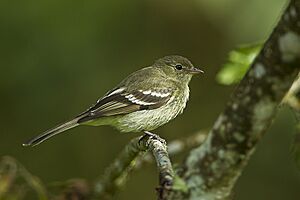Mountain elaenia facts for kids
Quick facts for kids Mountain elaenia |
|
|---|---|
 |
|
| Conservation status | |
| Scientific classification | |
| Genus: |
Elaenia
|
| Species: |
frantzii
|
| Subspecies | |
|
See text |
|
 |
|
The mountain elaenia (Elaenia frantzii) is a small passerine bird. It belongs to the tyrant flycatcher family. These birds live in the highlands from Guatemala all the way to Colombia and western Venezuela. Its scientific name honors Alexander von Frantzius, a German physician and naturalist.
Contents
What Does a Mountain Elaenia Look Like?
This small tyrant flycatcher is about 14 to 15 centimeters (5.5 to 5.9 inches) long. It weighs around 17 to 20 grams (0.6 to 0.7 ounces).
Its upper parts are a dull olive green. It has a thin white ring around its eyes. The wings are dark with thin yellow edges on the feathers. You can also see two off-white bars on its wings. The throat and chest are a yellowish-grey color. This color turns into a dull yellow on its belly.
Male and female mountain elaenias look very similar. However, young birds are usually browner on top. They are also paler underneath and have brighter wing bars.
Where Do Mountain Elaenias Live?
There are four different types, or subspecies, of mountain elaenias. Each type lives in slightly different areas:
- Elaenia frantzii ultima – This type is found in southern Mexico (Chiapas), Guatemala, El Salvador, and Honduras.
- Elaenia frantzii frantzii – This type lives in Nicaragua, Costa Rica, and western Panama.
- Elaenia frantzii browni – You can find this type in northern Colombia and northwestern Venezuela.
- Elaenia frantzii pudica – This type lives in northern and eastern Colombia, as well as northern and western Venezuela.
How Do Mountain Elaenias Behave?
The mountain elaenia is a bit shy and not always easy to spot. It makes a slurred peeeeur sound. Its song is a repeating d’weet d’weet. When it's not breeding, this bird prefers to be alone.
Reproduction and Nests
Mountain elaenias build their nests in wet mountain forests. They prefer the edges of forests, clearings, or open areas with trees. They usually breed at altitudes between 1,200 and 2,900 meters (3,900 and 9,500 feet). In winter, they move to lower areas, sometimes as low as 600 meters (2,000 feet). They also seem to move around seasonally.
The female bird builds a cup-shaped nest. It's made of mosses, liverworts, and lichens. The inside is lined with soft plant fibers. The nest is usually built 2 to 15 meters (6.6 to 49 feet) high in a tree or bamboo plant.
The female lays two whitish eggs. These eggs have cinnamon-colored spots. She sits on the eggs to keep them warm for 15 to 16 days until they hatch.
What Do Mountain Elaenias Eat?
This bird often sits on a shaded branch, watching for food. From its perch, it quickly flies out to catch insects and spiders. It also eats many berries and seeds. It picks its food from leaves or even from the ground. All of its food is caught while it is flying.



